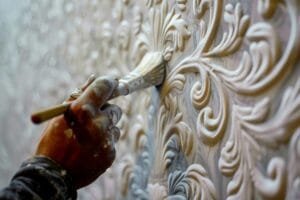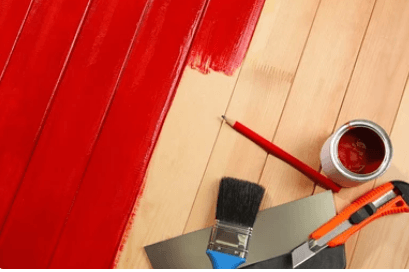Introduction to Trendy Texture Paints
Mithila Paints, originating from the Mithila region of Bihar, India, are a vibrant representation of traditional Indian artistry. This unique form of painting, also known as Madhubani art, has roots that date back to ancient times, often linked with rituals and celebrations. Traditionally, women of the Mithila community used natural dyes and pigments to depict stories and themes from mythology, nature, and folklore on the walls of their homes and sacred spaces. As a cultural expression, these paintings serve not only as beautiful artifacts but also as a medium to convey rich narratives and traditions of the Mithila people.
In modern times, Mithila Paints have transcended their traditional boundaries, finding relevance in contemporary artwork and design. This evolution has opened the door for innovative techniques and materials, one of which is the introduction of texture paints. These contemporary adaptations maintain the essence of Mithila art while integrating modern aesthetics. Texture paints have begun to play a significant role in enhancing the visual depth and complexity of Mithila artwork, allowing artists to explore new dimensions and expressiveness.
The significance of Mithila Paints in the cultural fabric of India cannot be overstated. They are not merely decorative but serve as a testament to the skilled artistry passed down through generations. The influence of this traditional art form is evident in various spheres, including home décor, fashion, and contemporary visual art. As artists experiment with texture paints, they honor the legacy of Mithila while simultaneously pushing the boundaries of creative expression in unique and exciting ways. Thus, texture paints not only enrich the aesthetic appeal of Mithila artistry but also encourage a deeper appreciation for its historical and cultural roots.
What are Texture Paints?
Texture paints are a specialized category of coatings designed to add dimension and character to various surfaces. Unlike standard paints, which provide a smooth finish, texture paints incorporate additives that create visually appealing structures and patterns. These paints are distinguished by their unique properties, which allow them to transform ordinary surfaces into artistic expressions, making them increasingly popular in both residential and commercial applications.
One of the critical features of texture paints is their ability to conceal imperfections on walls and ceilings. Their thick consistency enables them to cover minor blemishes and irregularities, providing a more uniform appearance. Additionally, texture paints can be formulated with a variety of textures, including sand, stone, or even bumpy surfaces, giving homeowners and designers multiple options for achieving their desired aesthetic.
There are several types of texture paints available in the market, each with distinct characteristics suitable for different applications. Some of the most common varieties include knockdown, popcorn, and stucco finishes. Knockdown texture provides a subtle yet eye-catching design with its flattened peaks, while popcorn texture adds a three-dimensional quality that can enhance sound absorption. Stucco texture, often utilized for exterior surfaces, offers durability and a rugged appearance. Each of these types can be customized in terms of color, allowing for endless creative possibilities.
Texture paints are not only limited to walls; they can also be used on furniture, ceilings, and even outdoor surfaces, making them versatile choices for interior and exterior design. When applied correctly, texture paints can create a captivating focal point or seamlessly blend into a larger design scheme. Their transformative power places texture paints at the forefront of contemporary design trends, especially within the realm of Mithila Paints, where traditional artistry meets modern innovation.

The Popularity of Texture Paints in Interior Design
In recent years, texture paints have garnered significant attention in the realm of interior design, transforming the aesthetic appeal of residential and commercial spaces alike. Interior designers are increasingly incorporating texture paints into their projects, using them to create visually engaging environments that transcend traditional paint applications. This innovative approach to wall finishes allows designers to experiment with depth, color, and pattern, ultimately enriching the overall ambiance of the spaces they design.
One of the primary reasons for the growing popularity of texture paints is their capacity to add character and interest to otherwise mundane surfaces. Unlike flat paints, texture paints offer a tactile quality that invites interaction and enhances sensory experiences. This depth becomes particularly vital in modern design, where minimalist aesthetics can sometimes risk feeling cold or uninviting. Through the use of texture paints, designers can evoke warmth and allure, encouraging a more immersive experience for occupants and visitors.
Moreover, texture paints are exceptionally versatile, permitting their integration into various styles, from contemporary to traditional. Designers leverage texture paints to complement existing architectural details or contrasting elements, reinforcing a cohesive theme throughout the space. For example, a rustic farmhouse kitchen may incorporate a textured off-white finish that harmonizes with exposed wooden beams, while a sleek urban loft could feature bold textured accents that reflect a chic, modern vibe.
The benefits of using texture paints extend beyond aesthetics; they also provide practical advantages. Textured surfaces can help disguise minor imperfections, which not only simplifies wall maintenance but also enhances the longevity of the paint job. With the increasing recognition of these advantages, it is no surprise that texture paints have become a favored choice among interior design professionals looking to make a lasting impression in their projects.
Exploring Current Trends in Texture Paints
In the realm of interior design, texture paints have garnered considerable attention, emerging as a transformative element in modern aesthetics. Among the various styles, texture paints have become popular for their unique ability to add depth and character to surfaces. Today, numerous current trends are defining the landscape of texture paints, emphasizing the integration of innovative colors, finishes, and application techniques.
One prominent trend is the shift toward earthy tones and neutral palettes, which align with contemporary minimalism. Variations of beige, taupe, and soft greens are increasingly favored, providing a calming backdrop that complements furniture and decors. These colors not only enhance the visual space but also create an inviting atmosphere. The use of these hues, coupled with textured finishes like matte or satin, enhances the dimension of the walls, making them appear more dynamic yet harmonious.
Another remarkable trend is the exploration of mixed-media finishes within texture paints. The use of metallic elements or reflective surfaces is becoming a popular choice among designers seeking to infuse vibrancy into interiors. Such combinations offer a striking contrast to the softness of matte textures, allowing for a contemporary feel that resonates with urban living spaces. Additionally, finishes like plaster and stucco are making a comeback, providing visual intrigue and timeless appeal.
Furthermore, sustainability in design is a significant focus for both consumers and manufacturers. Eco-friendly texture paints, which utilize natural ingredients and minimize harmful chemicals, are increasingly prevalent. This trend not only caters to health-conscious homeowners but also aligns with the broader movement towards environmentally responsible design practices. As such, texture paints that prioritize sustainability are becoming staples in modern design settings.
Through these trends, texture paints continue to evolve, providing a versatile tool for designers and homeowners alike to express individual style while adhering to contemporary design philosophies.
Application Techniques for Texture Paints
When it comes to applying texture paints, several techniques can be employed to achieve unique effects. Each method requires different tools and approaches, catering to both novice and experienced painters. The three most common application techniques are brushing, rolling, and spraying, each offering distinct advantages in texture creation.
Brushing is one of the traditional methods and allows for precise control over the texture’s direction and intensity. Select a high-quality brush with stiff bristles to ensure that the texture paint adheres well to the surface. To achieve a textured effect, dip the brush into the paint and apply it to the wall in a stippling or swirling motion. For a more layered look, consider overlapping strokes while the paint is still wet. This technique is particularly suitable for smaller surfaces or intricate designs commonly found in Mithila artworks.
Rolling is another effective method, ideal for larger areas. Using a textured roller can help create a uniform finish across the surface. Start by applying a base coat if necessary, allowing it to dry completely. Once ready, dip the roller into the texture paint and roll it across the surface using a consistent, even pressure. For varied textures, experiment with different rolling patterns, such as crossing over or rolling in different directions. This technique is efficient and produces a faster application while still offering a visually appealing finish.
Lastly, spraying is an advanced technique that can create seamless and more intricate textures. This method works best with a paint sprayer or air compressor, allowing for even distribution of the texture paint. Start by setting the sprayer to a low pressure for control, and test on a scrap piece. When ready, spray in sweeping motions, maintaining a consistent distance from the surface. This technique can be challenging but yields professional results, particularly for larger surfaces or murals inspired by Mithila painting.
Regardless of the technique chosen, it is essential to practice and understand how different surfaces and tools interact with texture paints to master these applications effectively.
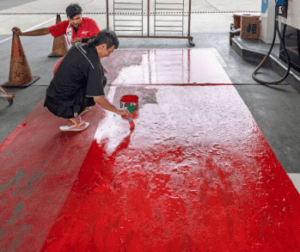
Combining Mithila Art with Texture Paints
Mithila art, with its rich history and vibrant aesthetic, has long been a celebrated form of expression rooted in the cultural heritage of Bihar, India. Traditionally characterized by intricate designs and vivid colors, Mithila paintings often depict themes drawn from nature, mythology, and daily life. In recent years, the introduction of texture paints has opened new avenues for artists and designers, allowing them to innovate and reinterpret this classic art form.
Texture paints, known for their capacity to add depth and tactile quality to surfaces, have been embraced by contemporary Mithila artists. By combining these paints with traditional techniques, they create wall art that not only preserves the essence of Mithila but also introduces a modern twist. For instance, the use of raised or embossed patterns can enhance the visual appeal and invite viewers to engage with artworks on a sensory level. This fusion leads to pieces that are not only visually striking but also rich in texture, inviting touch and interaction.
Numerous artists are experimenting with different formulations of texture paints, manipulating them to fit their artistic visions. Some utilize these products to accentuate specific features of their Mithila designs, while others create entirely new patterns inspired by modern themes. The result is a collection of artworks that honor the traditional forms yet resonate with contemporary design sensibilities. This approach has garnered attention in both local and global artistic communities, further promoting the relevance of Mithila art in today’s world.
As this trend continues to evolve, it is crucial to recognize the ongoing dialogue between tradition and modernity. The integration of texture paints into Mithila art not only highlights the adaptability of this cultural heritage but also ensures its preservation in a rapidly changing artistic landscape. This harmonious blend of old and new paves the way for innovative creations that captivate both art enthusiasts and casual observers alike.
DIY Projects Using Texture Paints
Texture paints offer an exciting opportunity to revamp personal and professional spaces, inciting creativity and innovation in various DIY projects. One approachable idea is to create an accent wall in a living room or workspace. By selecting a bold color and incorporating texture paint with a sponge or brush, you can establish a striking focal point that enhances the overall aesthetic. The process not only provides a unique visual experience but also allows an individual to express their personal style through texture contrasts.
Another popular DIY project involves furniture upcycling. Old wooden furnishings can be transformed using texture paints that mimic rustic or contemporary styles. Applying a textured finish to a wardrobe, coffee table, or a chair can bring new life to outdated items. Variations such as layering different colors or experimenting with application techniques can yield beautiful results. Choosing a matte or glossy finish will further cater to the furniture’s intended use and the space it occupies.
Moreover, decorative items like vases and picture frames can be enhanced with the incorporation of texture paints. A simple glass vase can be coated in textured paint to transform its appearance dramatically, making it an eye-catching centerpiece. Similarly, wooden frames can be painted to match other design elements in a room. These small yet impactful projects serve to enrich the surrounding environment and provide a sense of completion to the overall decors.
Regardless of the scale of the project, incorporating texture paints invites creativity and can result in fulfilling and gratifying outcomes. With a myriad of techniques and finishes available, individuals can embark on countless DIY endeavors. The versatility of texture paints makes them an exceptional choice not only for enhancing personal spaces but also for crafting unique gifts or decorative elements that reflect one’s artistic vision.
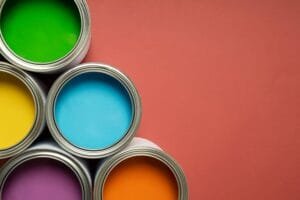
Choosing the Right Texture Paints
Selecting the appropriate texture paints for your projects requires careful consideration of various factors. One of the primary criteria is the compatibility of the paint with the base material of your project. Texture paints are available for diverse substrates such as wood, drywall, metal, and concrete. Ensuring that the paint is suited for your material will enhance adhesion and durability, leading to a longer-lasting finish.
Another important aspect to evaluate is the finish options that different texture paints offer. Finish choices can range from matte to high-gloss, with various textures such as sand, stucco, or even smooth finishes available. Depending on the design aesthetics you aim to achieve, the finish will significantly influence the final appearance of your project. A rougher finish may suit exterior walls well, while a smoother finish might be preferable for interiors.
Maintenance is yet another factor to consider. Some texture paints may require specific cleaning methods or touch-ups over time. Understanding the maintenance requirements beforehand will help you manage expectations and keep your surfaces looking fresh. Additionally, consider the longevity of the paint, as some products may fade or deteriorate faster than others. Consulting the product specifications can be beneficial to gauge expected lifespan under standard conditions.
Furthermore, when choosing texture paints, exploring brands renowned for their quality is advisable. Trusted brands typically offer reliable performance and a range of options suited for various applications. Brands like Behr, Sherwin-Williams, and Benjamin Moore are often recommended for their texture paint lines. By taking these factors into account, you can make an informed choice that aligns with your project’s needs and desired outcomes.
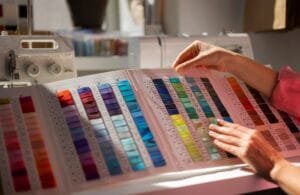
Conclusion: The Future of Texture Paints in Mithila Art
As we reflect on the evolving landscape of texture paints within Mithila art, it becomes evident that this traditional art form is undergoing a significant transformation. The integration of texture paints introduces new dimensions to the intricate storytelling for which Mithila art is well-known, allowing artists to explore contemporary themes while staying rooted in tradition. Artists are increasingly experimenting with various materials and techniques, leading to innovative outcomes that redefine the visual appeal of their work.
The dialogue between tradition and modernity is essential in this context. Traditional Mithila artists are beginning to see texture paints not merely as additional embellishments, but as integral components that expand the narrative possibilities within their artworks. This shift indicates a broader tendency among artists to experiment with mixed media, combining traditional styles with modern techniques to forge new aesthetic paths. Such evolution enriches the cultural heritage of Mithila, ensuring it remains relevant in a rapidly changing world.
Moreover, the growing global interest in Mithila art signifies a market ripe for innovation. International exhibitions and collaborations between traditional artists and contemporary creators are likely to introduce Mithila art to fresh audiences. This exposure paves the way for new creative partnerships, leading to the development of novel texture paint techniques that could revolutionize this genre even further. As artists embrace advancements in materials and technology, we may witness the emergence of unique styles that blend the literate history of Mithila art with modern artistic expressions.
Ultimately, the future of texture paints in Mithila art holds exciting prospects. With the ongoing interplay of tradition and innovation, we can anticipate a vibrant evolution that not only honors the past but also fosters a creative environment for future generations. Embracing these changes may very well pave the way for a dynamic and enriched Mithila art scene in years to come.
